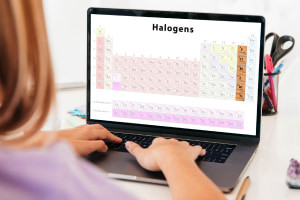
Advanced Level
Intermediate Chemistry: Halogens & Alkaline Earth Metals
- Learners already enrolled
Intermediate Chemistry: Halogens & Alkaline Earth Metals
This free online chemistry course focuses on the physical and chemical properties of halogens and alkaline earth metals.
This chemistry course explains group 2 elements (alkaline earth metals) and group 17 elements (halogens), shows where they are on the periodic table and their electronic structures, and describes the physical... This chemistry course explains group 2 elements (alkaline earth metals) and group 17 elements (halogens), shows where they are on the periodic table and their electronic structures, and describes the physical and chemical properties of each. We explore the interactions of alkali earth metals with oxygen and water, the reactions of halogens with metals, non-metals, hydrogen and sulfuric acid, and some of their industrial applications.
COURSE PUBLISHER -
What You Will Learn In This Free Course
- -
- -
- -
- -
Complete This CPD Accredited Course & Get Your Certificate!
Certify Your Skills
A CPD accredited Alison Diploma/Certificate certifies the skills you’ve learnedStand Out From The Crowd
Add your Alison Certification to your resumé and stay ahead of the competitionAdvance in Your Career
Share your Alison Certification with potential employers to show off your skills and capabilities
Learner Reviews & Feedback
Intermediate Chemistry: Halogens & Alkaline Earth Metals
View More Reviews
Back to top
Back to course information
Want to create a customised learning path for your team?
Our dedicated Learning Advisors are here to help you curate a customised learning path tailored to your organisation's needs and goals.
Not sure where to begin?
Discover the career most suitable for you and get started in the field with a step-by-step plan.
Get your Plan
















 Avg. Hours
Avg. Hours  CPD Accredited
CPD Accredited 
 Total XP:
Total XP: 
 Knowledge & Skills You Will Learn
Knowledge & Skills You Will Learn 


